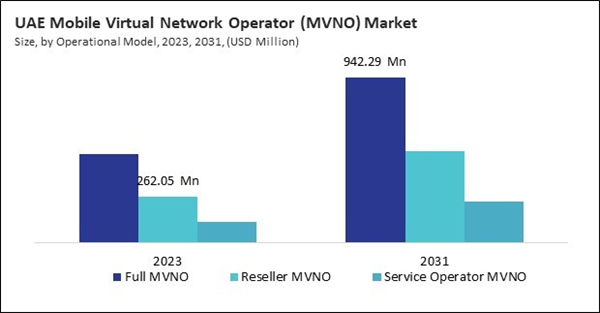The Latin America, Middle East and Africa Mobile Virtual Network Operator (MVNO) Market is expected to witness market growth of 9.6% CAGR during the forecast period (2024-2031).
The Brazil market dominated the LAMEA Mobile Virtual Network Operator (MVNO) Market by country in 2023, and is expected to continue to be a dominant market till 2031; thereby, achieving a market value of $2.74 billion by 2031. The Argentina market is registering a CAGR of 11.1% during 2024-2031. Additionally, the UAE market is expected to obtain a CAGR of 8.8% during 2024-2031.
Environmentally conscious MVNOs are emerging and appealing to consumers who prioritize green initiatives. These operators might offset carbon emissions, use eco-friendly packaging, or donate profits to environmental causes, aligning their brands with the values of younger generations. This shift reflects broader societal pressures for businesses to adopt sustainable practices. Finally, consolidation and partnerships are on the rise. Some MVNOs merge to achieve economies of scale, while others forge deeper alliances with MNOs to secure better wholesale rates or exclusive features. These trends signal a maturing market where collaboration and specialization are key to long-term success.
Innovation is the lifeblood of the MVNO model, enabling these operators to differentiate themselves in a crowded field. One area of innovation is customer experience. MVNOs leverage artificial intelligence (AI) and machine learning to offer personalized plans, predict usage patterns, and provide proactive support. Chatbots and AI-driven apps streamline interactions, making it easier for users to manage their accounts or troubleshoot issues.
The UAE is positioning itself as a global leader in AI, with expectations that the sector will contribute over 14% of the country’s GDP ($96 billion) by 2030. The rapid annual growth of AI’s economic impact, projected at 33.5% between 2018 and 2030, signals a major shift towards digital and data-driven services. AI-driven customer service, automated network management, and predictive analytics enhance MVNO operations by providing better user experiences, reducing churn rates, and enabling personalized offerings. AI also plays a crucial role in fraud detection, optimizing data plans, and driving mobile-based financial services, which are key differentiators for MVNOs in the competitive telecom landscape. Thus, the combined impact of blockchain adoption in Saudi Arabia and AI growth in the UAE fosters an environment where MVNOs can thrive.
The Brazil market dominated the LAMEA Mobile Virtual Network Operator (MVNO) Market by country in 2023, and is expected to continue to be a dominant market till 2031; thereby, achieving a market value of $2.74 billion by 2031. The Argentina market is registering a CAGR of 11.1% during 2024-2031. Additionally, the UAE market is expected to obtain a CAGR of 8.8% during 2024-2031.
Environmentally conscious MVNOs are emerging and appealing to consumers who prioritize green initiatives. These operators might offset carbon emissions, use eco-friendly packaging, or donate profits to environmental causes, aligning their brands with the values of younger generations. This shift reflects broader societal pressures for businesses to adopt sustainable practices. Finally, consolidation and partnerships are on the rise. Some MVNOs merge to achieve economies of scale, while others forge deeper alliances with MNOs to secure better wholesale rates or exclusive features. These trends signal a maturing market where collaboration and specialization are key to long-term success.
Innovation is the lifeblood of the MVNO model, enabling these operators to differentiate themselves in a crowded field. One area of innovation is customer experience. MVNOs leverage artificial intelligence (AI) and machine learning to offer personalized plans, predict usage patterns, and provide proactive support. Chatbots and AI-driven apps streamline interactions, making it easier for users to manage their accounts or troubleshoot issues.
The UAE is positioning itself as a global leader in AI, with expectations that the sector will contribute over 14% of the country’s GDP ($96 billion) by 2030. The rapid annual growth of AI’s economic impact, projected at 33.5% between 2018 and 2030, signals a major shift towards digital and data-driven services. AI-driven customer service, automated network management, and predictive analytics enhance MVNO operations by providing better user experiences, reducing churn rates, and enabling personalized offerings. AI also plays a crucial role in fraud detection, optimizing data plans, and driving mobile-based financial services, which are key differentiators for MVNOs in the competitive telecom landscape. Thus, the combined impact of blockchain adoption in Saudi Arabia and AI growth in the UAE fosters an environment where MVNOs can thrive.
List of Key Companies Profiled
- Deutsche Telekom AG
- Verizon Communications Inc.
- AT&T Inc.
- Boost Mobile
- Consumer Cellular, Inc.
- Red Pocket
- Lyca Mobile
- FreenetAG
Market Report Segmentation
By Contract Type
- Prepaid MVNO
- Postpaid MVNO
By End-use
- Consumer
- Enterprise
By Service Type
- 4G MVNO
- 5G MVNO
- Other Service Type
By Operational Model
- Full MVNO
- Reseller MVNO
- Service Operator MVNO
By Type
- Discount
- Migrant
- Retail
- Telecom
- M2M
- Roaming
- Media
- Other Type
By Country
- Brazil
- Argentina
- UAE
- Saudi Arabia
- South Africa
- Nigeria
- Rest of LAMEA
Table of Contents
Chapter 1. Market Scope & Methodology
Chapter 2. Market at a Glance
Chapter 3. Market Overview
Chapter 4. LAMEA Mobile Virtual Network Operator (MVNO) Market by Contract Type
Chapter 5. LAMEA Mobile Virtual Network Operator (MVNO) Market by End-use
Chapter 6. LAMEA Mobile Virtual Network Operator (MVNO) Market by Service Type
Chapter 7. LAMEA Mobile Virtual Network Operator (MVNO) Market by Operational Model
Chapter 8. LAMEA Mobile Virtual Network Operator (MVNO) Market by Type
Chapter 9. LAMEA Mobile Virtual Network Operator (MVNO) Market by Country
Chapter 10. Company Profiles
Companies Mentioned
- Deutsche Telekom AG
- Verizon Communications Inc.
- AT&T Inc.
- Boost Mobile
- Consumer Cellular, Inc.
- Red Pocket
- Lyca Mobile
- FreenetAG
Methodology

LOADING...









